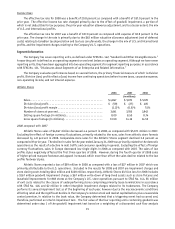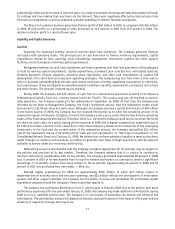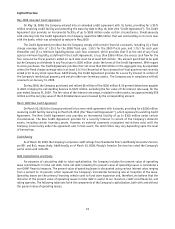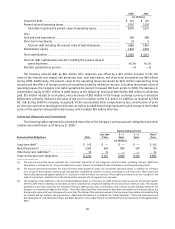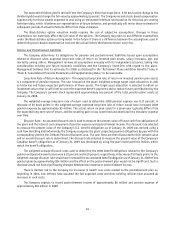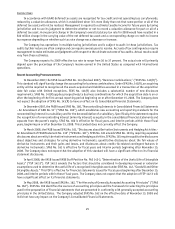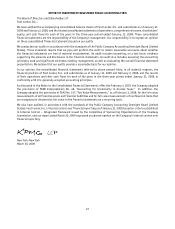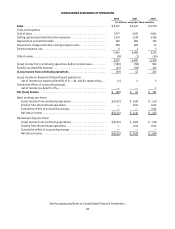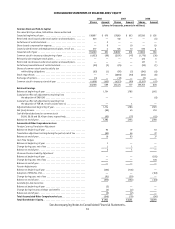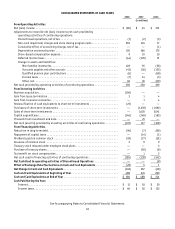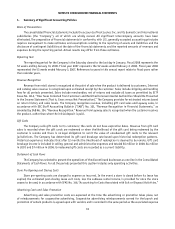Foot Locker 2008 Annual Report Download - page 41
Download and view the complete annual report
Please find page 41 of the 2008 Foot Locker annual report below. You can navigate through the pages in the report by either clicking on the pages listed below, or by using the keyword search tool below to find specific information within the annual report.
25
Income Taxes
In accordance with GAAP, deferred tax assets are recognized for tax credit and net operating loss carryforwards,
reduced by a valuation allowance, which is established when it is more likely than not that some portion or all of the
deferred tax assets will not be realized. Management is required to estimate taxable income for future years by taxing
jurisdiction and to use its judgment to determine whether or not to record a valuation allowance for part or all of a
deferred tax asset. A one percent change in the Company’s overall statutory tax rate for 2008 would have resulted in a
$10 million change in the carrying value of the net deferred tax asset and a corresponding charge or credit to income
tax expense depending on whether such tax rate change was a decrease or increase.
The Company has operations in multiple taxing jurisdictions and is subject to audit in these jurisdictions. Tax
audits by their nature are often complex and can require several years to resolve. Accruals of tax contingencies require
management to make estimates and judgments with respect to the ultimate outcome of tax audits. Actual results could
vary from these estimates.
The Company expects its 2009 effective tax rate to range from 36 to 37 percent. The actual rate will primarily
depend upon the percentage of the Company’s income earned in the United States as compared with international
operations.
Recent Accounting Pronouncements
In December 2007, the FASB issued SFAS No. 141 (Revised 2007), “Business Combinations,” (“SFAS No. 141(R)”).
This standard will significantly change the accounting for business combinations. Under SFAS No. 141(R), an acquiring
entity will be required to recognize all the assets acquired and liabilities assumed in a transaction at the acquisition
date fair value with limited exceptions. SFAS No. 141(R) also includes a substantial number of new disclosure
requirements. SFAS No. 141(R) applies prospectively to business combinations for which the acquisition date is on or
after the beginning of the first annual reporting period beginning on or after December 15, 2008. The Company does
not expect the adoption of SFAS No. 141(R) to have an affect on its Consolidated Financial Statements.
In December 2007, the FASB issued SFAS No. 160, “Noncontrolling Interests in Consolidated Financial Statements
- An Amendment of ARB No. 51” (“SFAS No. 160”), which establishes new accounting and reporting standards for the
noncontrolling interest in a subsidiary and for the deconsolidation of a subsidiary. Specifically, this statement requires
the recognition of a noncontrolling interest (minority interest) as equity in the consolidated financial statements and
separate from the parent’s equity. SFAS No. 160 is effective for fiscal years, and interim periods within those fiscal
years, beginning on or after December 15, 2008. This standard does not currently affect the Company.
In March 2008, the FASB issued SFAS No. 161, “Disclosures about Derivative Instruments and Hedging Activities -
An Amendment of FASB Statement No. 133” (“SFAS No. 161”). SFAS No. 161 amends SFAS No. 133 by requiring expanded
disclosures about an entity’s derivative instruments and hedging activities. SFAS No. 161 requires qualitative disclosures
about objectives and strategies for using derivative instruments, quantitative disclosures about the fair values of
derivative instruments and their gains and losses, and disclosures about credit-risk-related contingent features in
derivative instruments. SFAS No. 161 is effective for fiscal years and interim periods beginning after November 15,
2008. The Company does not expect that the adoption of this standard will have a significant effect on its financial
statement disclosures.
In April 2008, the FASB issued FASB Staff Position No. FAS 142-3, “Determination of the Useful Life of Intangible
Assets” (“FSP 142-3”). FSP 142-3 amends the factors that should be considered in developing renewal or extension
assumptions used to determine the useful life of a recognized intangible asset under SFAS No. 142, “Goodwill and Other
Intangible Assets.” This FSP is effective for financial statements issued for fiscal years beginning after December 15,
2008, and interim periods within those fiscal years. The Company does not expect that the adoption of FSP 142-3 will
have a significant effect on its financial statements.
In May 2008, the FASB issued SFAS No. 162, “The Hierarchy of Generally Accepted Accounting Principles” (“SFAS
No. 162”). SFAS No. 162 identifies the sources of accounting principles and the framework for selecting the principles
used in the preparation of financial statements that are presented in conformity with generally accepted accounting
principles in the United States. The Company adopted SFAS No. 162 on the effective date of November 13, 2008 and
it did not have any impact on the Company’s Consolidated Financial Statements.


